When it comes to wardrobe essentials, jeans are a classic choice. They’re comfortable, versatile, and always in style.
But have you ever wondered if your favorite pair of jeans could actually get moldy? It might sound surprising, but the answer is yes.
In this article, we’ll delve into the world of moldy jeans, exploring why it happens, how to spot it, and most importantly, how to prevent it.
Quick Navigation
Why is there mold on my jeans?
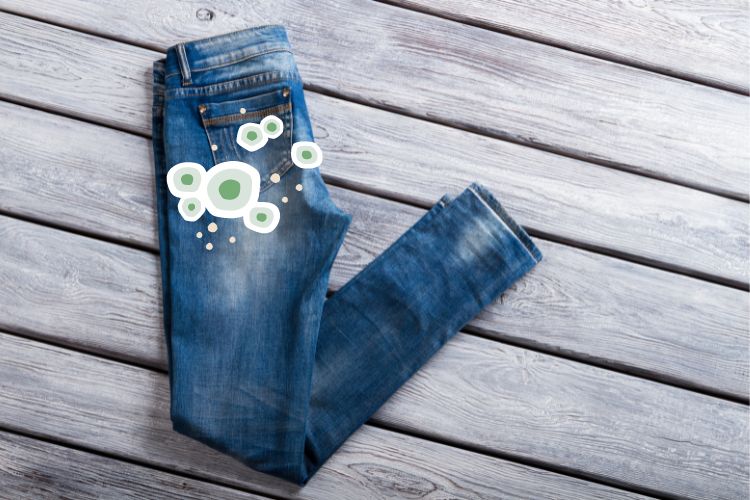
Mold is a type of fungus that loves damp, dark, and poorly ventilated environments. Unfortunately, these conditions can sometimes be found right in your own closet.
If you’ve ever worn your jeans all day and noticed that they feel damp or sweaty, you’re providing the perfect breeding ground for mold.
Add in the moisture from the air and the cozy confines of your closet, and you’ve got a recipe for mold growth.
How long does it take for jeans to mold?
Mold doesn’t set up camp overnight, but it doesn’t take an eternity either.
Depending on the conditions, mold can start growing on your jeans within a matter of days to weeks. Warm and humid environments are especially inviting to mold spores.
However, if you accidentally leave your jeans in a laundry hamper for a short time, you’re unlikely to find them suddenly covered in mold. It’s a gradual process that requires the right combination of moisture and time.
What does mold look like on jeans?
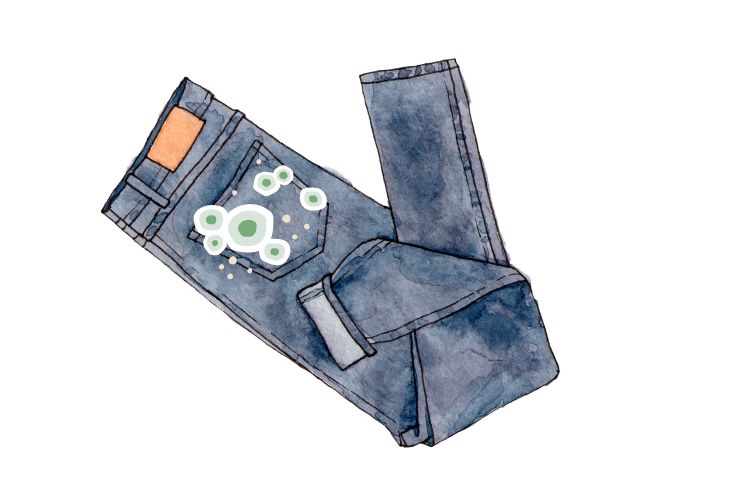
Spotting mold on your jeans can be a bit tricky, but there are some telltale signs.
Keep an eye out for discolored patches that can range from green and black to white. These patches might have a fuzzy or powdery texture, almost like a light dusting of snow.
If your jeans start to resemble a science experiment, it’s time to take action.
Can you remove mold from jeans?
Absolutely, rescuing your moldy jeans is possible! It requires a bit of elbow grease and the right approach.
Here’s a step-by-step guide on how to bid farewell to that unwanted mold and salvage your denim dreams:
Step 1. Isolate the Affected Area
Before you start the cleaning process, take your jeans outside. This prevents mold spores from spreading indoors and finding new places to settle.
Step 2. Brush off Loose Mold
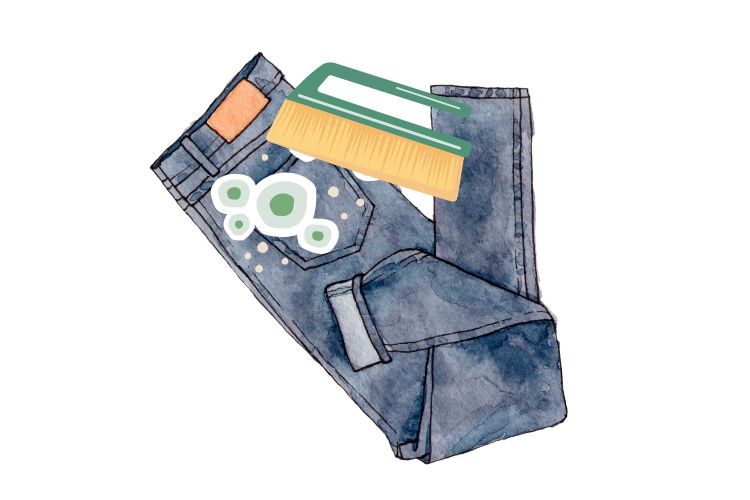
Armed with a soft-bristle brush, gently but thoroughly remove any loose mold from the surface of your jeans. Be sure to do this step outside to prevent releasing mold spores indoors.
Step 3. Washing Time
Method 1: Vinegar Soak
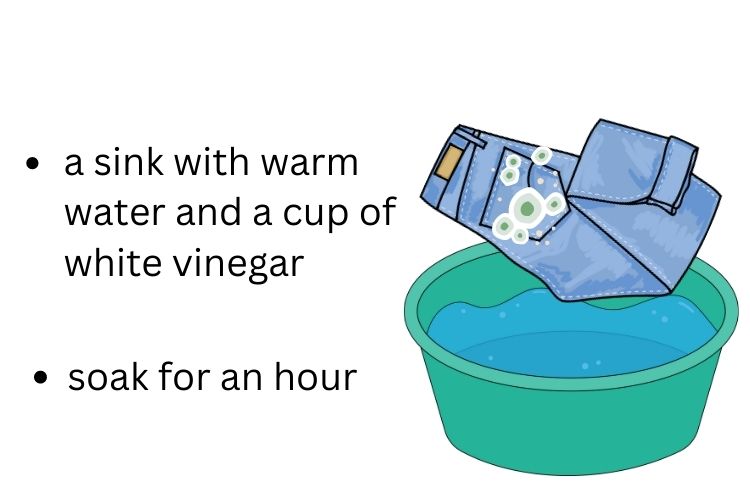
Fill a basin or sink with warm water and add a cup of white vinegar.
Next, let your jeans soak in this solution for about an hour.
Vinegar is known for its mold-fighting properties and can help loosen and kill mold.
Method 2: Baking Soda Scrub

Create a paste by mixing baking soda with a little water.
Then apply the paste directly to the moldy areas of your jeans and gently scrub with a soft brush.
Baking soda acts as a gentle abrasive that can help remove mold stains.
Step 4. Hot Water Wash
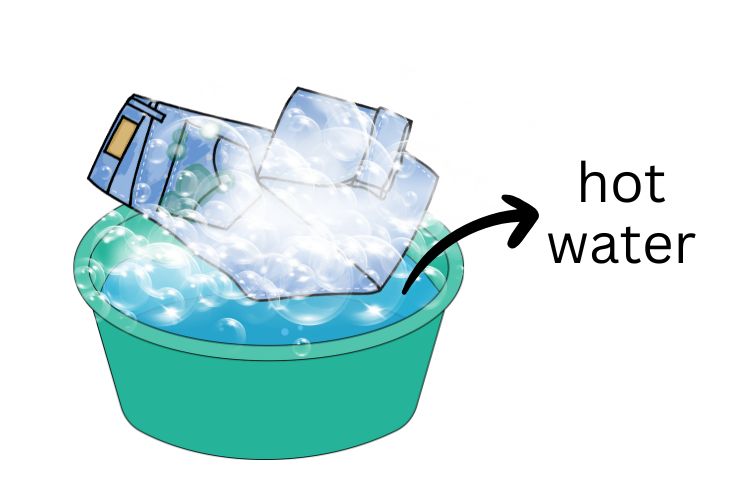
After the soaking or scrubbing, wash your jeans in hot water.
Hot water helps to kill remaining mold spores and lift stains.
Follow the care label instructions on your jeans to ensure you’re using the appropriate water temperature.
Step 5. Sun-Drying

Once your jeans are clean, let them air dry in direct sunlight and skip the dryer this time.
Sunlight has natural anti-microbial properties that can help further kill any remaining mold spores and remove lingering odors.
Step 6. Check for Residue
After drying, inspect your jeans for any remaining signs of mold.
If there are still discolorations or a musty smell, consider repeating the cleaning process. Done!
Prevention and Maintenance
Preventing mold growth on your jeans is a much easier endeavor than dealing with it once it’s taken hold.
Above all, regular maintenance is key. Make sure to wash your jeans regularly to remove sweat and dirt, which can contribute to mold growth.
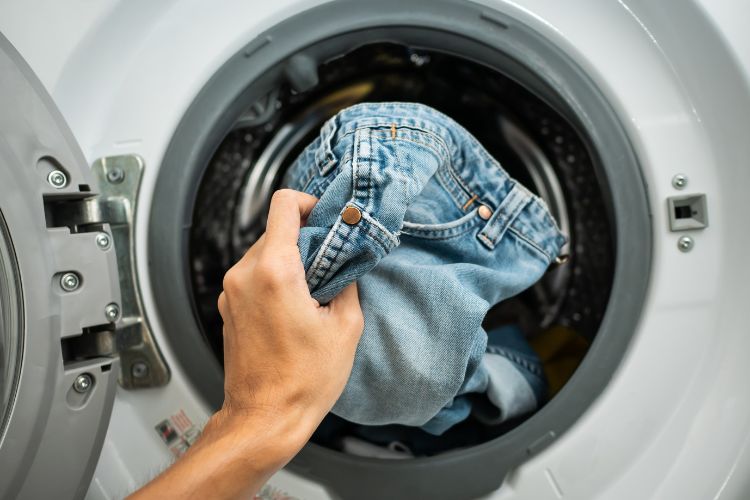
Remember to avoid letting your jeans stay wet for too long, as prolonged dampness can create a cozy habitat for mold.
Before storing, ensure your jeans are completely dry, as mold thrives in damp conditions.
Hanging your jeans in a well-ventilated space or using breathable garment bags can help maintain their freshness.
Remember to give your jeans a breather between wears as well. Rotating them and avoiding consecutive days of wearing allows them to air out and prevents excessive moisture buildup.
Additionally, consider the overall environment – using dehumidifiers and allowing proper ventilation in your storage spaces can go a long way in preventing mold.
Conclusion
Your jeans might be your go-to attire for various occasions, but even they aren’t immune to the potential threat of mold.
By understanding why mold grows on jeans, how to recognize it, and the steps to prevent and treat it, you can extend the lifespan of your beloved denim companions.
Remember, a little care and attention can keep your jeans looking great and mold-free for countless stylish adventures to come.
Hi, I’m Grace Alision, a fashion lover with a passion for helping women feel confident and beautiful through their style choices. I created this website to share my love for wedding guest dresses and, in the future, to explore concert outfit inspiration. Dresses have always been my favorite way to express elegance and individuality, and I’m here to make finding the perfect outfit fun and easy. When I’m not working on outfit ideas, I love discovering new trends and connecting with others who share my love for fashion.

